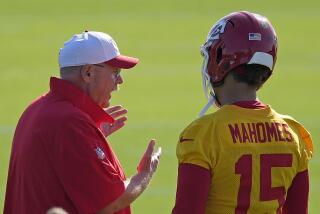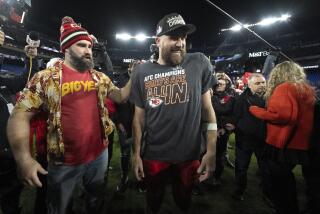PRO FOOTBALL : Kansas City Can Go Fast, Faster, Fastest
- Share via
KANSAS CITY, Mo. — Last year, when the Kansas City Chiefs were already proud possessors of the NFL’s most feared straight-ahead running back, Christian Okoye, they reached out and brought in Barry Word, another big, and even faster, back.
Then in the first round of the draft last April, they loaded up with yet another one, Harvey Williams, who was evaluated by some scouts as the year’s best young ballcarrier.
Some pro clubs, by contrast, can hardly put their hands on one respectable backfield performer. Are the Chiefs trying to corner the market?
“You can’t have too many (backs) when they’re all different types,” says club President Carl Peterson. “Word is a changeup for Okoye--and Williams is a great changeup for either or both of them.
“When you have a 260-pound hammer (Okoye), you pound. For variety, (the Chiefs) can go to a 240-pound back (Word) with the speed to get outside. Then we can change to real speed (Williams)--a 220-pound sprinter.”
Okoye stands 6 feet 1, the others 6-2, meaning that as running backs, none suffers from the clumsiness of too much height. It isn’t an accident that so many of the game’s better backs are relatively short.
“We aren’t the first pro club to have three kinds of great backs,” Peterson says. “The old Miami Dolphins, remember, had Larry Csonka, Jim Kiick and Mercury Morris--a big back, a changeup and a burner. All they did that year (1972) was finish 17-0.”
Switch channels: The New Orleans Saints may not prove it every week, but they’re a team with two No. 1 quarterbacks, club President Jim Finks says, identifying Bobby Hebert and Steve Walsh.
“The difference between them is that Hebert can carry a ballclub,” Finks says. “Walsh is a guy who needs some talent around him. The quarterback he reminds me of the most is Bob Griese.
“There’s no way that Griese can win a Super Bowl without great players in the skill positions. But when the Miami Dolphins had that greatness, Griese was a cool, take-charge guy who could take them to 17-0.”
Role models: It comes as no great surprise that two of the league’s most successful new leaders, Peterson of the Chiefs and Finks of the Saints, are so prone to discussing the early-1970s Dolphins.
Their teams have been modeled in part on Griese, Csonka, Kiick and Morris, and in part on Miami’s defense.
If Okoye is Kansas City’s Csonka, the New Orleans hammer is 270-pound Craig (Ironhead) Heyward.
If Griese, no more than Walsh, could have done it himself, that goes in spades for Kansas City quarterback Steve DeBerg.
Some would say that the 1991 Saints even evoke memories of Coach Don Shula’s no-name defense at Miami in 1972. With their regulars, the Saints stuffed the Chicago Bears for 58 minutes Sunday before changing to a prevent- type alignment that cost them the game.
The Chiefs have somewhat spoiled their no-name image with linebacker Derrick Thomas, safety Deron Cherry and other names, but don’t blame Peterson for that.
Losers still losing: Just as New York often seems the most provincial of American cities, the NFL seems the most provincial of the major leagues. Consider:
--In the years when Finks was a success story in Canadian football, nobody in the NFL was interested in him until the Minnesota Vikings, desperate, finally brought him down to turn their team around.
--Although Peterson and New Orleans Coach Jim Mora were big winners in the old United States Football League, the NFL wasn’t interested in either until the Saints finally brought in Finks--who brought in Mora. Only later did the Chiefs call in Peterson.
Any number of NFL owners who are still losing--the owners of the Atlanta Falcons, Pittsburgh Steelers and Tampa Bay Buccaneers come to mind--could have had Peterson years ago. Or Finks. Or Mora.
The Chiefs, indeed, could themselves have had Peterson years ago. What has he done for them lately?
“We’ve come from far behind to second (to Buffalo) in NFL attendance,” he says with forgivable pride, for an NFL president is paid to sell tickets. “We’ve led the league in percentage increase in season-ticket sales all four years.”
In 78,067-seat Arrowhead Stadium, those sales have risen annually in the Peterson years from 24,800 to 31,000 to 43,000 to 53,000.
Monday night’s was the fifth of what, all told, will be seven home sellouts for the Chiefs this season in an eight-game schedule. In their second start, they drew only 76,000 for the Saints.
“People didn’t believe in the Saints in September,” Peterson says.
Despite a bad two minutes in the Bear game, they do now.
Optimum seating 65,000: By the mid-1990s, the Coliseum in Los Angeles will have shriveled from 92,000 to about 72,000. But that’s still too large, Peterson says, based on his football experiences.
“You can’t have a sound NFL operation, financially, without selling out every game,” he says. “There’s only an eight-game (home) season.
“If you seat more than 65,000, only one or two places in the league can count on sellouts, win or lose, because people won’t buy season tickets if they can pick and choose individual games.
“It’s questionable if Los Angeles is one of those places. There’s too much to do in L.A.”
New star: Short and bulky Ricky Ervins of the Washington Redskins, who was playing for USC a year ago, has emerged this month as the NFL’s standout new ballcarrier.
“He has the power, speed, and body control of the game’s better backs,” Redskin Coach Joe Gibbs said after Ervins’ big second half against the New York Giants Sunday night.
The Redskins, however, the league’s only 8-0 team, need one more victory to be considered a dominant team. It’s no cinch that they can turn back the run-and-shoot Houston Oilers Sunday.
Help wanted: They aren’t billing it as minor league football, but that, at first, is what it would be if the Professional Spring Football League gets off the ground five months from now.
Ten PSFL teams are planned for Boston, Florida, Las Vegas, Albuquerque, N.M., and elsewhere.
The commissioner, Rex Lardner Jr., who says player salaries will average $45,000, is taking player applications on a hotline, 800-Ask-PSFL.
Quote Department:
Al Davis, Raider owner, on the immaculate reception play that delivered the AFC title to Pittsburgh over the Raiders one winter: “If they’d had instant replay in that era, we might have played in more Super Bowls than anybody.”
Davis on TV officiating: “If they could put a missile down a smokestack (in the Persian Gulf), they can perfect instant-replay technology.”
Mike Ditka on no-huddle football: “It isn’t all bad. We may experiment with it--but I’d rather experiment with scoring points.”
Marty Schottenheimer, Kansas City coach, on Buffalo’s no-huddle approach: “It saves ( the Bills ) a lot of time. They do pretty much what they want to do against ( any defense ) , so they don’t have to waste time studying films.”
Haywood Jeffires, Houston wide receiver, on the concussions he has received lately from defensive teams that can’t think of any other way to stop run-and-shoot football: “Half the time, I didn’t know where I was, but I didn’t let the defense know that. (You) get hit whether you catch the ball or not, so you might as well catch it.”
More to Read
Go beyond the scoreboard
Get the latest on L.A.'s teams in the daily Sports Report newsletter.
You may occasionally receive promotional content from the Los Angeles Times.










